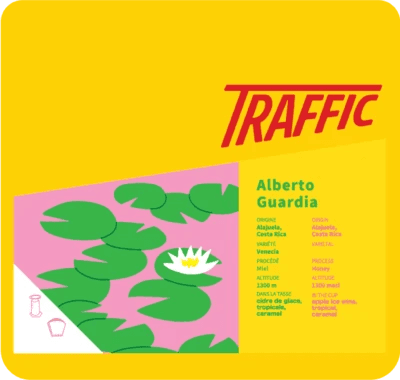Th3rdwave Directories
Cafés
Roasters
Coffees
Guides
Awards
Th3rdwave Coffee Club
Subscription
Gift subscription
Current edition
Past editions
Shop
Advent Calendar
Coffee games
Th3rdwave Wallet
Loyalty cards
Gift cards
Th3rdwave for cafés
Th3rdwave for roasters
Get free coffee
Alberto Guardia
Costa Rica has eight recognized coffee-growing regions. Central Valley was the very first producing regions. In fact, it is in 1820 that the first export of coffee to Panama was ever recorded. Central Valley is made up of the three major provinces: San José, Heredia and Alajuela.
This coffee is sourced from Hacienda Sonora, a family-owned farm located in Central Valley.
In the 70’s when Alberto Guardia, the current owner, took over the farm he began planting the majority of the land with coffee and shortly after it became the main source of income. At the end of the 90’s with historical low coffee prices Alberto invested in a Mill to maximize his quality. By doing so, he became a pioneer in very alternative processing techniques, such as Honey and Natural. Today, it has more than 20 different varietals of plants in 80 hectares of coffee, and over 20 hectares of forest reserve.
Hacienda Sonora also strives to have a positive impact on the environment. As such, all the energy consumed by the farm is 100 percent renewable energy that's harvested on the farm and powers the mill and electricity for workers.
The Venecia variety is a natural mutation of Caturra, which was originated in Venecia of San Carlos, Costa Rica. These trees look like a dwarf version of a Caturra tree, and one of its main attributes is that the cherries get ripe very late into the summer. This allows these plots to be picked last; hence reaching a very high brix content that is reflected in the cup profiles of rich, roundly sweet-tart and deep florals that prevail in the long aftertaste.
This coffee is sourced from Hacienda Sonora, a family-owned farm located in Central Valley.
In the 70’s when Alberto Guardia, the current owner, took over the farm he began planting the majority of the land with coffee and shortly after it became the main source of income. At the end of the 90’s with historical low coffee prices Alberto invested in a Mill to maximize his quality. By doing so, he became a pioneer in very alternative processing techniques, such as Honey and Natural. Today, it has more than 20 different varietals of plants in 80 hectares of coffee, and over 20 hectares of forest reserve.
Hacienda Sonora also strives to have a positive impact on the environment. As such, all the energy consumed by the farm is 100 percent renewable energy that's harvested on the farm and powers the mill and electricity for workers.
The Venecia variety is a natural mutation of Caturra, which was originated in Venecia of San Carlos, Costa Rica. These trees look like a dwarf version of a Caturra tree, and one of its main attributes is that the cherries get ripe very late into the summer. This allows these plots to be picked last; hence reaching a very high brix content that is reflected in the cup profiles of rich, roundly sweet-tart and deep florals that prevail in the long aftertaste.
Costa Rica has eight recognized coffee-growing regions. Central Valley was the very first producing regions. In fact, it is in 1820 that the first export of coffee to Panama was ever recorded. Central Valley is made up of the three major provinces: San José, Heredia and Alajuela.
This coffee is sourced from Hacienda Sonora, a family-owned farm located in Central Valley.
In the 70’s when Alberto Guardia, the current owner, took over the farm he began planting the majority of the land with coffee and shortly after it became the main source of income. At the end of the 90’s with historical low coffee prices Alberto invested in a Mill to maximize his quality. By doing so, he became a pioneer in very alternative processing techniques, such as Honey and Natural. Today, it has more than 20 different varietals of plants in 80 hectares of coffee, and over 20 hectares of forest reserve.
Hacienda Sonora also strives to have a positive impact on the environment. As such, all the energy consumed by the farm is 100 percent renewable energy that's harvested on the farm and powers the mill and electricity for workers.
The Venecia variety is a natural mutation of Caturra, which was originated in Venecia of San Carlos, Costa Rica. These trees look like a dwarf version of a Caturra tree, and one of its main attributes is that the cherries get ripe very late into the summer. This allows these plots to be picked last; hence reaching a very high brix content that is reflected in the cup profiles of rich, roundly sweet-tart and deep florals that prevail in the long aftertaste.
This coffee is sourced from Hacienda Sonora, a family-owned farm located in Central Valley.
In the 70’s when Alberto Guardia, the current owner, took over the farm he began planting the majority of the land with coffee and shortly after it became the main source of income. At the end of the 90’s with historical low coffee prices Alberto invested in a Mill to maximize his quality. By doing so, he became a pioneer in very alternative processing techniques, such as Honey and Natural. Today, it has more than 20 different varietals of plants in 80 hectares of coffee, and over 20 hectares of forest reserve.
Hacienda Sonora also strives to have a positive impact on the environment. As such, all the energy consumed by the farm is 100 percent renewable energy that's harvested on the farm and powers the mill and electricity for workers.
The Venecia variety is a natural mutation of Caturra, which was originated in Venecia of San Carlos, Costa Rica. These trees look like a dwarf version of a Caturra tree, and one of its main attributes is that the cherries get ripe very late into the summer. This allows these plots to be picked last; hence reaching a very high brix content that is reflected in the cup profiles of rich, roundly sweet-tart and deep florals that prevail in the long aftertaste.
Coffee origin
Country
Costa Rica
Region
Alajuela
Variety
venecia
Altitude
1300 m
Farm
Hacienda Sonora
Producer
Alberto Guardia
Process
honey
Tastes like
🥂
apple ice wine
🍮
caramel
🍍
tropical fruits
Community reviews
😐
2.0 Below Average
1 Review
What people are saying

JeanPhilippe
4 years ago
Cappu et cortado très savoureux du Canard 🦆

JeanPhilippe
4 years ago
Délicieux cortado du café Canard ça démarre bien le début de semaine !

Alejandro Farias
4 years ago
Très bon. I had issues dialing in the right grind for it/my gear. I thought it lacked a bit of body but it was excellent overall

Félix Langevin Harnois
4 years ago
Très bon

Cédrík Henrik
4 years ago
On m’a offert une boite ☕️Th3rdwave ☕️ pour Noel ! 🎅🏼😍 quelle belle idée!!! Hate de goûter ça !





